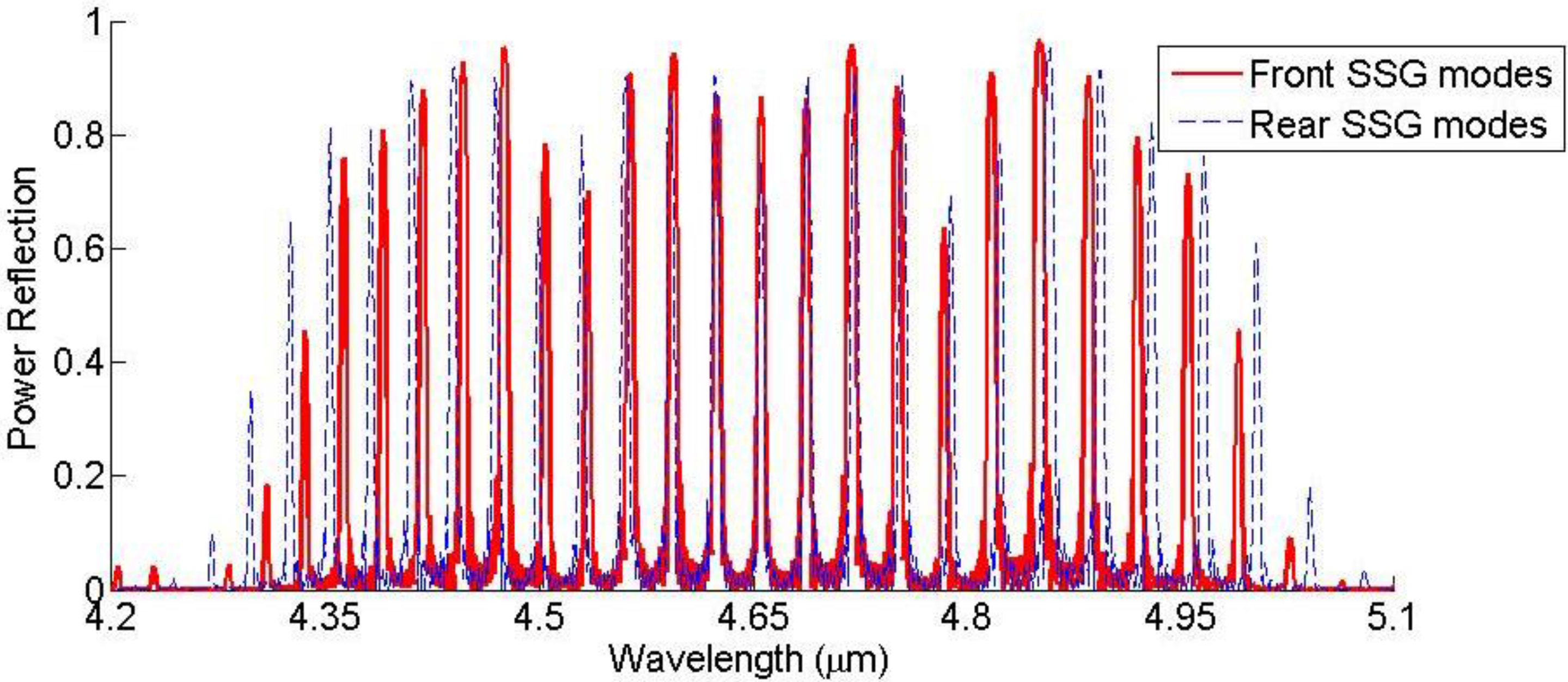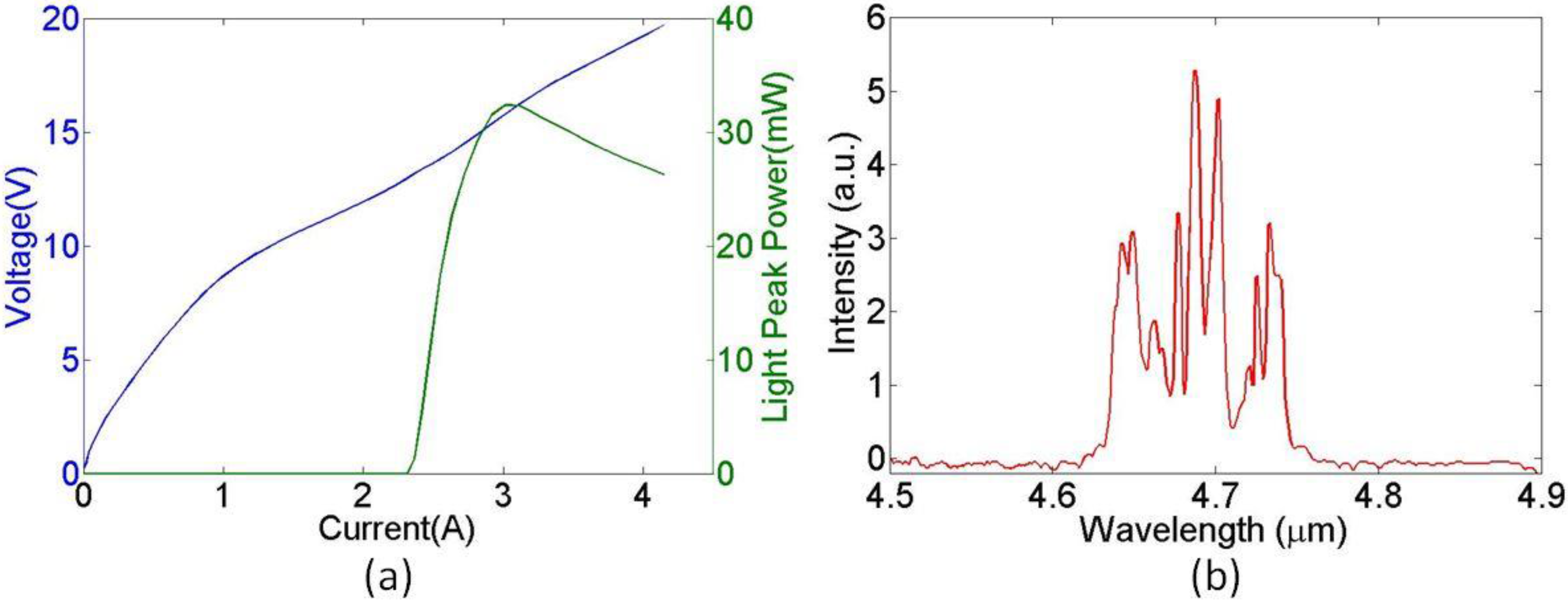Widely Tunable Monolithic Mid-Infrared Quantum Cascade Lasers Using Super-Structure Grating Reflectors
Abstract
:1. Introduction
2. Device Design and Simulation
3. Device Fabrication
4. Experimental Results
5. Summary and Outlook
Acknowledgments
Author Contributions
Conflicts of Interest
References
- Kosterev, A.; Wysocki, G.; Bakhirkin, Y.; So, S.; Lewicki, R.; Fraser, M.; Tittel, F.; Curl, R.F. Application of quantum cascade lasers to trace gas analysis. Appl. Phys. 2008, 90, 165–176. [Google Scholar] [CrossRef]
- Chen, X.; Cheng, L.; Guo, D.; Kostov, Y.; Choa, F.-S. Quantum cascade laser based standoff photoacoustic chemical detection. Opt. Express 2011, 19, 20251–20257. [Google Scholar] [CrossRef] [PubMed]
- Chen, X.; Guo, D.; Choa, F.-S.; Wang, C.-C.; Trivedi, S.; Snyder, A.P.; Ru, G.; Fan, J. Standoff photoacoustic detection of explosives using quantum cascade laser and an ultrasensitive microphone. Appl. Opt. 2013, 52, 2626–2632. [Google Scholar] [CrossRef] [PubMed]
- Martini, R.; Whittaker, E.A. Quantum cascade laser-based free space optical communications. J. Opt. Fiber. Commun. Rep. 2005, 2, 279–292. [Google Scholar] [CrossRef]
- Bai, Y.; Slivken, S.; Darvish, S.R.; Haddadi, A.; Gokden, B.; Razeghi, M. High power broad area quantum cascade lasers. Appl. Phys. Lett. 2009, 95, 221104. [Google Scholar] [CrossRef]
- Lyakh, A.; Maulini, R.; Tsekoun, A.; Go, R.; Patel, C.K.N. Multiwatt long wavelength quantum cascade lasers based on high strain composition with 70% injection efficiency. Opt. Express 2012, 20, 24272–24279. [Google Scholar] [CrossRef] [PubMed]
- Guo, D.; Cheng, L.; Chen, X.; Choa, F.-S.; Fan, J.; Worchesky, T. Electrical derivative measurement of quantum cascade lasers. J. Appl. Phys. 2011, 109, 043105. [Google Scholar] [CrossRef]
- Hugi, A.; Terazzi, R.; Bonetti, Y.; Wittmann, A.; Fischer, M.; Beck, M.; Faist, J.; Gini, E. External cavity quantum cascade laser tunable from 7.6 to 11.4 μm. Appl. Phys. Lett. 2009, 95, 061103. [Google Scholar] [CrossRef]
- Gmachl, C.; Straub, A.; Colombelli, R.; Capasso, F.; Sivco, D.L.; Sergent, A.M.; Cho, A.Y. Single-mode, tunable distributed-feedback and multiple-wavelength quantum cascade lasers. IEEE J. Quant. Electron. 2002, 38, 569–581. [Google Scholar] [CrossRef]
- Cheng, L.; Chen, X.; Choa, F.-S.; Worchesky, T. Integrated tunable DBR quantum cascade lasers with 30 cm−1 tuning range at 4.7 μm. Proc. SPIE 2010, 7616, 761618. [Google Scholar]
- Xie, F.; Caneau, C.; LeBlanc, H.; Coleman, S.; Hughes, L.C.; Zah, C.-E. Pulsed wavelength tuning and continuous wave operation of distributed bragg reflector quantum cascade lasers. Lasers Electro-Opt. (CLEO) 2012. [Google Scholar] [CrossRef]
- Lee, B.G.; Zhang, H.A.; Pflügl, C.; Diehl, L.; Belkin, M.A.; Fischer, M.; Wittmann, A.; Faist, J.; Capasso, F. Broadband distributed-feedback quantum cascade laser array operating from 8.0 to 9.8 μm. IEEE Photon. Technol. Lett. 2009, 21, 914–916. [Google Scholar] [CrossRef]
- Mansuripur, T.S.; Menzel, S.; Blanchard, R.; Diehl, L.; Pflügl, C.; Huang, Y.; Ryou, J.-H.; Dupuis, R.D.; Loncar, M.; Capasso, F. Widely tunable mid-infrared quantum cascade lasers using sampled grating reflectors. Opt. Express 2012, 20, 23339–23348. [Google Scholar] [CrossRef] [PubMed]
- Diba, A.S.; Xie, F.; Gross, B.; Caneau, C.; Hughes, L.C.; Zah, C.-E.; Moshary, F. Application of a broadly tunable SG-DBR QCL for multi-species trace gas spectroscopy. Opt. Express 2015, 23, 27123–27133. [Google Scholar] [CrossRef] [PubMed]
- Slivken, S.; Bandyopadhyay, N.; Tsao, S.; Nida, S.; Bai, Y.; Lu, Q.Y.; Razeghi, M. Sampled grating, distributed feedback quantum cascade lasers with broad tunability and continuous operation at room temperature. Appl. Phys. Lett. 2012, 100, 261112. [Google Scholar] [CrossRef]
- Slivken, S.; Bandyopadhyay, N.; Bai, Y.; Lu, Q.Y.; Razeghi, M. Extended electrical tuning of quantum cascade lasers with digital concatenated gratings. Appl. Phys. Lett. 2013, 103, 231110. [Google Scholar] [CrossRef]
- Jayaraman, V.; Chuang, Z.-M.; Coldren, L.A. Theory, design and performance of extended tuning range semiconductor lasers with sampled gratings. IEEE J. Quant. Electron. 1993, 29, 569–581. [Google Scholar] [CrossRef]
- Ishii, H.; Tanobe, H.; Kano, F.; Tohmori, Y.; Kondo, Y.; Yoshikuni, Y. Quasicontinuous wavelength tuning in super-structure-grating (SSG) DBR lasers. IEEE J. Quant. Electron. 1996, 32, 433–441. [Google Scholar] [CrossRef]
- Oberg, M.; Rigole, P.; Nilsson, S.; Klinga, T.; Backbom, L.; Streubel, K.; Wallin, J.; Kjellberg, T. Complete single mode wavelength coverage over 40 nm with a super structure grating DBR laser. J. Lightwave Technol. 1995, 13, 1892–1898. [Google Scholar] [CrossRef]
- Bismuto, A.; Bidaux, Y.; Tardy, C.; Terazzi, R.; Gresch, T.; Wolf, J.; Blaser, S.; Muller, A.; Faist, J. Extended tuning of mid-ir quantum cascade lasers using integrated resistive heaters. Opt. Express 2015, 23, 29715–29722. [Google Scholar] [CrossRef] [PubMed]
- Bidaux, Y.; Bismuto, A.; Tardy, C.; Terazzi, R.; Gresch, T.; Blaser, S.; Muller, A.; Faist, J. Extended and quasi-continuous tuning of quantum cascade lasers using superstructure gratings and integrated heaters. Appl. Phys. Lett. 2015, 107, 221108. [Google Scholar] [CrossRef]
- Yamada, M.; Sakuda, K. Analysis of almost-periodic distributed feedback slab waveguides via a fundamental matrix approach. Appl. Opt. 1987, 26, 3473–3478. [Google Scholar] [CrossRef] [PubMed]
- Evans, A.; Yu, J.S.; Slivken, S.; Razeghi, M. Continuous-wave operation of λ~4.8 μm quantum-cascade laser at room temperature. Appl. Phys. Lett. 2004, 85, 2166. [Google Scholar] [CrossRef]
- Heijden, R.V.D.; Andriesse, M.S.P.; Carlstrom, C.-F.; Drift, E.V.D.; Geluk, E.-J.; Heijden, R.W.V.D.; Karouta, F.; Nouwens, P.; Oei, Y.S.; Vries, T.D.; et al. Deep dry etching process development for photonic crystals in InP based planar waveguides. Proc. SPIE Photonic Cryst. Mater. Nanostruct. 2004, 5450. [Google Scholar] [CrossRef]
- Uchiyama, H.; Shinoda, K.; Sato, H.; Take, A.; Taniguchi, T.; Tsuji, S. Smooth and anisotropic dry etching of InGaAlAs using Cl2/N2 ECR plasma. IEEE IRPM 2003, 468–471. [Google Scholar] [CrossRef]
- Guilet, S.; Bouchoule, S.; Jany, C.; Corr, C.S.; Chabert, P. Optimization of a Cl2–H2 inductively coupled plasma etching process adapted to nonthermalized InP wafers for the realization of deep ridge heterostructures. J. Vac. Sci. Technol. B 2006, 24, 2381–2387. [Google Scholar] [CrossRef]
- Gatilova, L.; Bouchoule, S.; Patriarche, G.; Guilet, S. Addition of Si-containing gases for anisotropic etching of III–V materials in chlorine-based inductively coupled plasma. Jpn. J. Appl. Phys. 2011, 50, 08JE02. [Google Scholar] [CrossRef]
- Strasser, P.; Wiiest, R.; Robin, F.; Emi, D.; Jacke, H. Process optimization for dry etching of InP-InGaAsP-based photonic crystals with a Cl2/CH4/H2 mixture on an ICP-RIE. IEEE IPRM 2004. [Google Scholar] [CrossRef]
- Cheng, L.; Fan, J.; Janssen, D.; Guo, D.; Chen, X.; Towner, F.J.; Choa, F.-S. Analysis of InP regrowth on deep-etched mesas and structural characterization for buried-heterostructure quantum cascade lasers. J. Electron. Mater. 2012, 41, 506–513. [Google Scholar] [CrossRef]






| Symbol | Quantity | Designed/Measured Value |
|---|---|---|
| Λ1, Λ2, Λ3, Λ4, Λ5 | Front grating pitch list (and the length for each pitch in one SSG period) | 772 nm (23.9 μm), 752 nm (21.1 μm), 732 nm (22.7 μm), 712 nm (19.9 μm), 692 nm (21.5 μm) |
| Λs | Front SSG period | 109.07 μm |
| Δλs | Front SSG mode separation | 31.17 nm |
| Lf | Total Front SSG length | 0.98 mm (9 SSG periods) |
| Λ1’, Λ2’, Λ3’, Λ4’, Λ5’ | Rear grating pitch list (and the length for each pitch in one SSG period) | 776 nm (23.28 μm), 754 nm (20.36 μm), 732 nm (21.96 μm), 710 nm (19.17 μm), 688 nm (20.64 μm) |
| Λs’ | Rear SSG period | 105.41 μm |
| Δλs’ | Rear SSG mode separation | 32.25 nm |
| Lr | Total Rear SSG length | 0.95 mm (9 SSG periods) |
| neff | Effective refractive index | 3.18 |
| Δneff | neff modulation depth | 0.012 |
| κ | Grating coupling coefficient | 40 cm−1 |
© 2016 by the authors; licensee MDPI, Basel, Switzerland. This article is an open access article distributed under the terms and conditions of the Creative Commons Attribution (CC-BY) license (http://creativecommons.org/licenses/by/4.0/).
Share and Cite
Guo, D.; Li, J.-Y.; Cheng, L.; Chen, X.; Worchesky, T.; Choa, F.-S. Widely Tunable Monolithic Mid-Infrared Quantum Cascade Lasers Using Super-Structure Grating Reflectors. Photonics 2016, 3, 25. https://doi.org/10.3390/photonics3020025
Guo D, Li J-Y, Cheng L, Chen X, Worchesky T, Choa F-S. Widely Tunable Monolithic Mid-Infrared Quantum Cascade Lasers Using Super-Structure Grating Reflectors. Photonics. 2016; 3(2):25. https://doi.org/10.3390/photonics3020025
Chicago/Turabian StyleGuo, Dingkai, Jiun-Yun Li, Liwei Cheng, Xing Chen, Terry Worchesky, and Fow-Sen Choa. 2016. "Widely Tunable Monolithic Mid-Infrared Quantum Cascade Lasers Using Super-Structure Grating Reflectors" Photonics 3, no. 2: 25. https://doi.org/10.3390/photonics3020025




